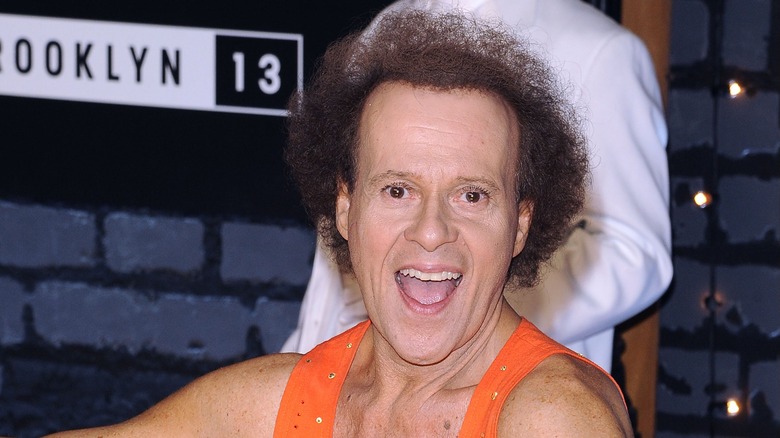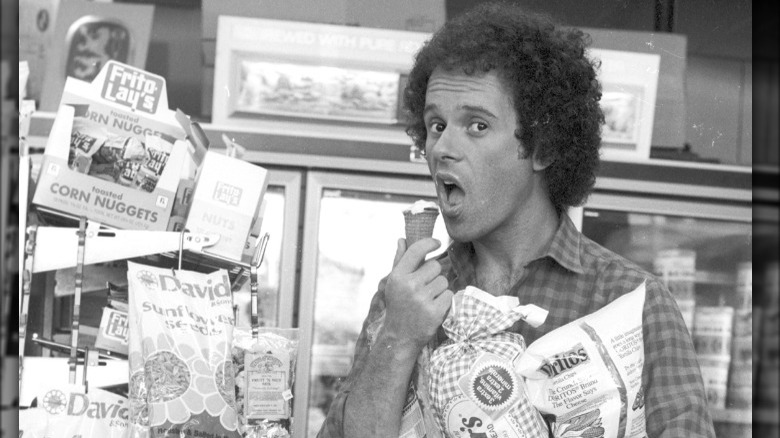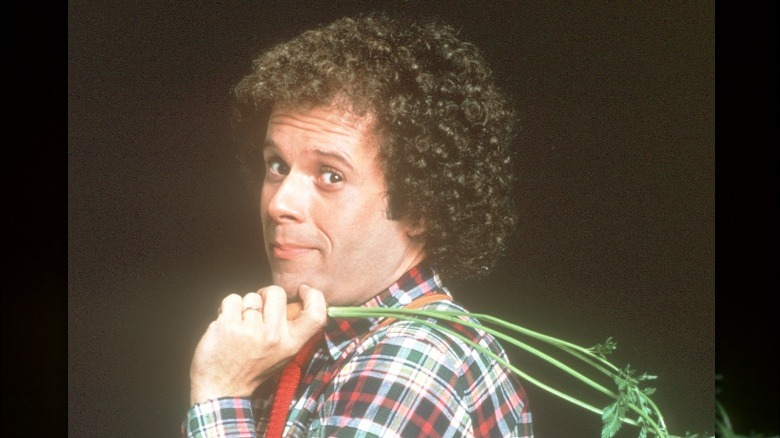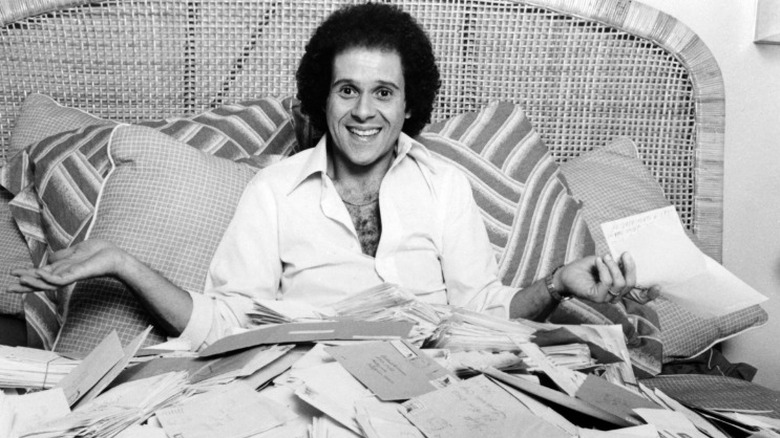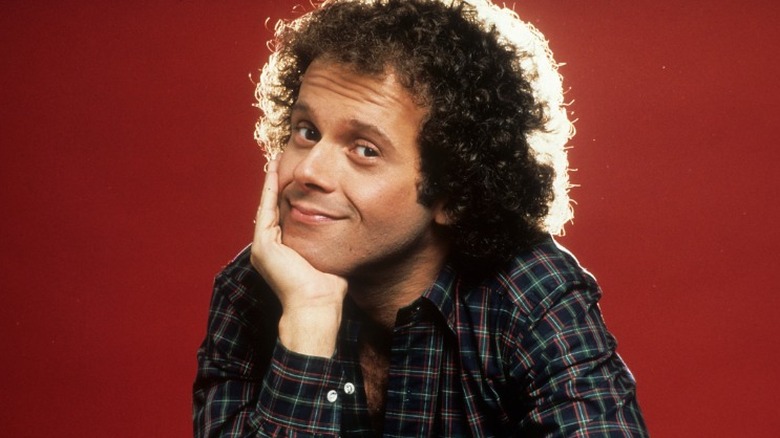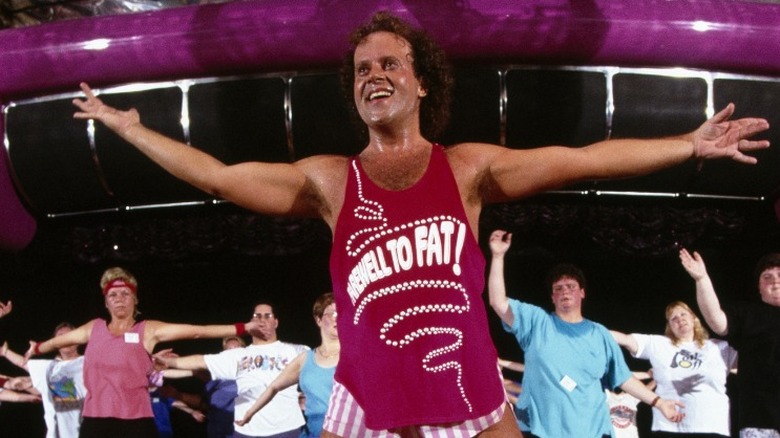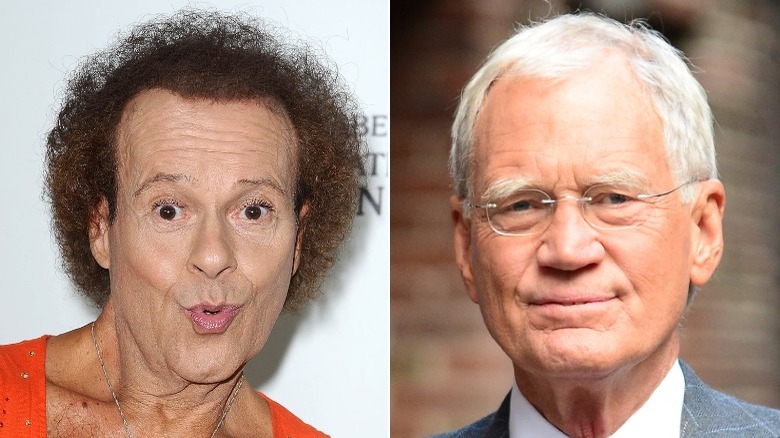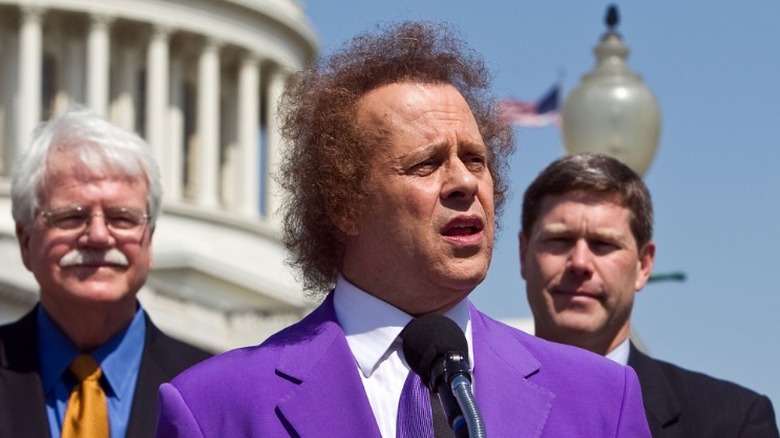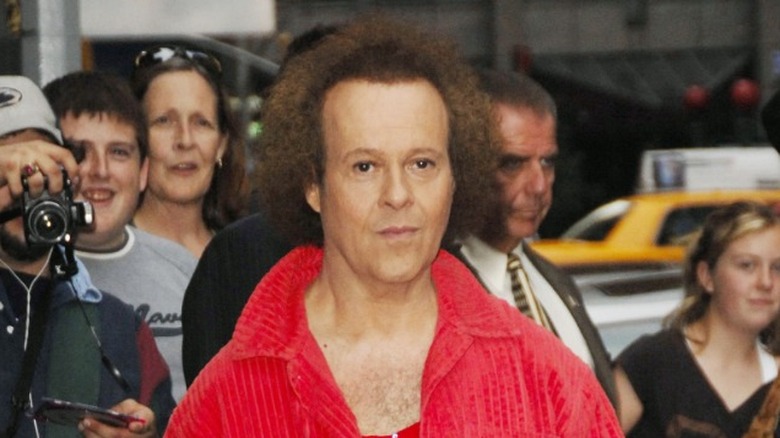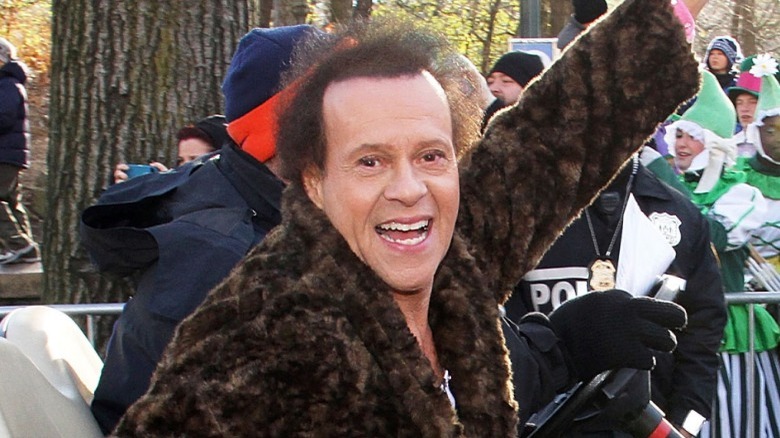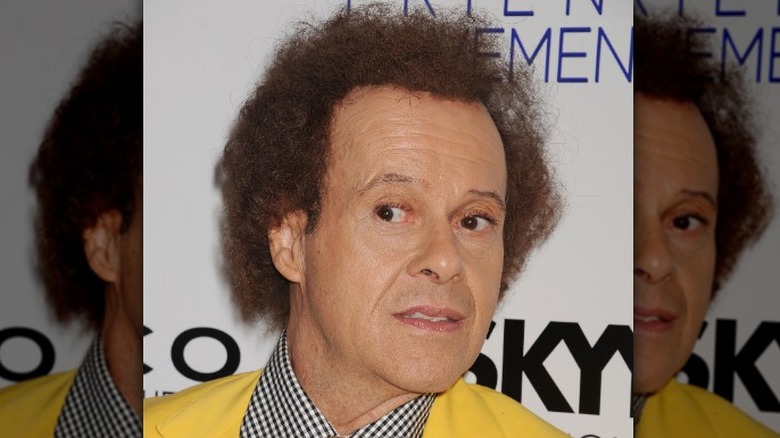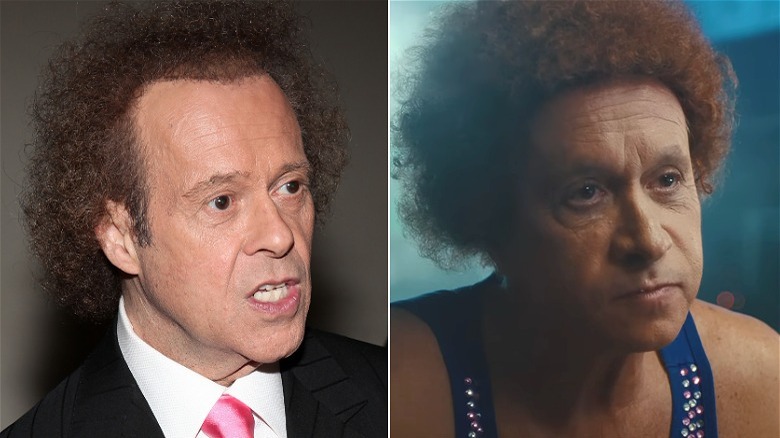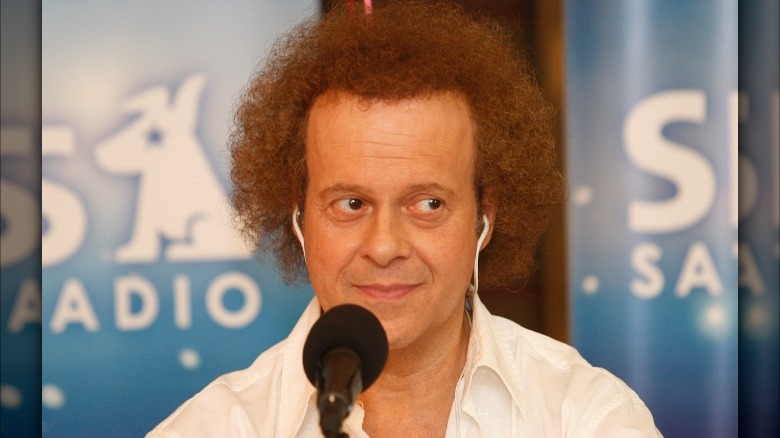The Untold Truth Of Richard Simmons
Note: This article includes mentions of eating disorders.
In an ever-changing world of countless health and fitness personalities, influencers, and celebrities, Richard Simmons has remained a singular talent. Decked out in his signature rhinestone-encrusted tank tops and Dolfin shorts, Simmons dazzled the public for decades with his jester-like antics and boundless enthusiasm for healthy living. Born Milton Teagle Simmons in New Orleans, his transformation from an overweight kid from the French Quarter into an exuberant fitness and health guru is a journey of both tragedy and triumph, a story Simmons has never hesitated to share. Simmons started his fitness empire from the ground up, turning his Beverly Hills fitness studio into a billion-dollar merchandising empire.
His uncanny ability to connect with his fans has endeared him to generations of wellness seekers, but when Richard Simmons vanished from the spotlight in 2014, it left a mysterious void in the pop culture landscape. Despite his radical transparency in sharing his life story, Simmons has always been rather enigmatic, mostly keeping his private life to himself. So who exactly is Richard Simmons? Read on to find out the truth about this dazzling, yet mysterious pop culture icon.
His dramatic childhood weight journey led to serious health problems
Before Richard Simmons became a pop culture fitness phenom, he struggled with his own health. Born in 1948, Simmons arrived without a full set of bones in his foot, a birth defect that impacted the health of his legs, mental health, and physical well-being. Growing up in New Orleans, he heavily indulged in regional cuisine. He told Men's Health, "When I was younger, I ate nothing but fried food. Everything was fried, from oysters to chicken to potatoes to vegetables." He also wasn't physically active, preferring to sit on the sidelines and eat junk food rather than play sports.
In middle school, Richard weighed 200 pounds. He peaked at 268 pounds and throughout his childhood, Simmons took drastic measures to control his weight. He shared on "View from the Cheap Seats with the Sklar Brothers" that growing up, he ingested diet pills and laxatives, and he struggled with eating disorders. Simmons' weight caused him immense distress and he feared that being overweight would ultimately cost him his life. As a result, he went on a crash diet of water and lettuce, dropping more than 100 pounds in mere months. He lost weight, but landed in the hospital, jeopardizing his health. This was a turning point in Simmons' life. He realized he wanted to help others who also struggled with their weight.
If you need help with an eating disorder or know someone who does, help is available. Visit the National Eating Disorders Association website or contact NEDA's Live Helpline at 1-800-931-2237. You can also receive 24/7 Crisis Support via text (send NEDA to 741-741).
Before fame, Simmons appeared in a famous director's movies and a number of commercials
Over the years, Richard Simmons has clearly not been afraid of the spotlight, and he honed his penchant for performance in some unlikely places. After dropping out of seminary school, Simmons attended Florida State University. Simmons studied in Florence, Italy as part of his college's exchange program. He studied art but managed to find some interesting side hustles while hitting the books. Simmons was an extra in Federico Fellini's 1969 film "Satyricon." His appearance in the film as Nymphomaniac's Slave is both unconfirmed and uncredited on IMDb. However, he confirmed his part in the movie in an interview with Men's Health in 2012. He is also credited with appearing in another Fellini movie called "The Clowns" in 1970.
He also starred in several Italian commercials. "I just stumbled into it," he told Men's Health. "I was sitting in a cafe in Florence one day and met somebody in casting and did a little something and then I met somebody else and they asked me to do something." In an interview with "Real People," Simmons said he was a grape in a Fruit of the Loom spot, a dancing hamburger, and a peanut butter spokesman.
His stint as a soap opera star made him a national celebrity
Richard Simmons arrived in Los Angeles in the early 1970s, where he quickly endeared himself to the Tinseltown set. He picked up a job at Derrick's, an Italian restaurant whose clientele included showbiz luminaries such as Johnny Carson and Sidney Poitier. He made a name for himself as a waiter and maître d' of Derrick's, but young Simmons wanted more. With his eyes set on healthful living on his own terms, he saved up his money from working at the restaurant, and in 1975, he opened The Anatomy Asylum (later Slimmons) and the salad bar Ruffage.
Located in Beverly Hills, Simmons' fitness studio boasted an impressive celebrity clientele, and important showbiz power players soon took notice. On a flight, he sat next to a TV executive who asked him to play himself on the long-running ABC soap opera "General Hospital." Simmons' storyline involved counseling characters on weight loss, and after just weeks of being on the show, Simmons received fan mail asking him for help. He now had a national platform, and as part of his "General Hospital" duties, he made paid shopping mall appearances. Not wanting to just sit and answer questions, Simmons started bringing his own music and working out with the crowd. Soon, Simmons was being asked to show up to malls solo with his fitness routines, reaching new audiences.
He had several talk shows
Early in his career, Richard Simmons raised his show-biz profile as an in-demand talk show guest, and in the early 1980s, he parlayed his chat show success into television stardom by hosting his own program called "The Richard Simmons Show." Beaming into living rooms across the country, the syndicated "The Richard Simmons Show" drew in millions of viewers with its mix of fitness routines, healthy cooking segments, and heartfelt interviews. Plus, Simmons starred in his own sketch comedy routines, creating zany characters like The Weight Saint and Reverend Pounds, putting a humorous spin on his serious health message.
"The Richard Simmons Show" didn't make it past the mid-'80s, but Simmons continued to be a daytime television staple. He appeared on game shows like "The New Hollywood Squares" and "Match Game," and he returned to host his own show called "Richard Simmons' Dream Maker" in 1999. This time around, Simmons made audience members' "dreams" come true, sometimes with the help of celebrity guests. Unfortunately, "Dream Maker" didn't provide any wish fulfillment in the ratings and it was canceled in its first season.
His billion-dollar merchandise empire
Richard Simmons grew his relatively humble Beverly Hills fitness studio into a billion-dollar wellness empire. According to License Global, Simmons moved $1.5 billion worth of his merchandise, and with sales like these, Simmons' products clearly wouldn't make the list of bizarre stuff celebs tried to sell us. In his early days, he found success in publishing, with "Richard Simmons' Never-Say-Diet Book" becoming a bestseller. And it's hard to imagine the TV infomercial without Richard Simmons. His telegenic presence made Simmons a natural infomercial star. In the late 1980s, he launched his Deal-A-Meal weight loss program. It was an immediate hit, and by 1988, he had sold hundreds of thousands of Deal-A-Meal card kits. That same year, Simmons released his first of five "Sweatin' the Oldies" workout videos.
While "Sweatin'" might be Simmons' best-known video workout, he released plenty of other fitness videos — 65 in total — with titles like "Boogie Down the Pounds," "Tone Up on Broadway," and "Tone & Sweat." In all, the New York Daily News (via E! News) reports that Simmons sold over 65 million units of his at-home workouts across different media mediums. Simmons developed all his own products and he turned down opportunities that didn't align with his values. Although he acknowledged that luck and blessings played into his success on "The Big Idea," Simmons credited steadfastly sticking to his long-term business plans as the source of his financial triumphs. "I've been really blessed," he said.
The truth behind his relationship with David Letterman
It's no secret that Richard Simmons made a great talk show guest and his goofy, often campy persona made him a great foil for legendary late-night host David Letterman. Simmons' first stop on "Late Night with David Letterman" was in 1991, and he followed Letterman over to CBS for over 30 appearances on "Late Show with David Letterman." Simmons, often clad in his signature Dolfin shorts and bedazzled tank tops, would usually be the butt of pranks.
Despite being a frequent guest on the show, Simmons never got to know the comedian. "You're just not allowed to talk to him. Or if you are, he's very standoffish," he told Men's Health of his time on the show. "Then the commercials are over and you're back, you sit down again and finish the show. Maybe that's just how he is with me, I don't know."
Letterman's treatment of Simmons was pretty shady, and Simmons took a six-year break from the show after a stunt with a fire extinguisher went awry. But "Late Show" staff have cited show moments featuring Simmons as some of their favorites, including photoshopping Simmons into Barbra Streisand's wedding photos and the time Simmons accompanied Letterman to New Jersey. Simmons made his last stop on "Late Show" in 2008.
His crusade for children's health
Not only has Richard Simmons counseled and inspired numerous adults on their health journeys over the years, but he has also advocated for children's health and fitness. Simmons worked for years to make physical education a priority in U.S. schools. The No Child Left Behind Act became federal law in 2002, deeply affecting K-12 curriculum across the country. However, after the legislation passed, some schools started to shorten gym classes and recess in order to meet new academic standards. While Simmons wasn't an active child himself, he understood how healthy movement and sound nutrition positively affected students' lives.
He told Education Week in 2007, "Kids learn more if they're physically active. My big question is: Why is nobody pushing to get PE back in our schools when it's the only answer we have to save our children?" Simmons co-created the FIT Kids Act with several members of the U.S. Congress, and Mr. Simmons went to Washington to testify on Capitol Hill in 2008. Of course, after delivering an impassioned plea to lawmakers, he changed out of his suit and into his workout clothes for an impromptu sweat sesh. The FIT Kids Act was formerly introduced and passed the House in 2009, with it being reintroduced in 2015. As of the publication of this article, it has yet to be signed into law.
His outgoing public persona hid his very private personal life
Richards Simmons' bombastic, high-energy persona has endeared him to legions of fans, so it might surprise you that when he was not working, Simmons led a low-key, very private life. Throughout his career, Simmons dedicated countless hours to personally connecting with his followers. He called dozens of people every day, and Simmons worked grueling hours, often pulling 14- or 15-hour days.
Richard Simmons lives in a palatial Hollywood Hills estate that he purchased in 1982 and it seems like it's been a sanctuary of sorts for the fitness icon. On "View from the Cheap Seats with the Sklar Brothers," Simmons said he doesn't hang out with anyone and lives a reclusive life, socializing with no one, and only having people over to his home for meetings. Even in his younger years, Simmons liked to keep to himself. In a 1981 interview with People, he declared, "I don't go to discos, bars, or parties." He also dismissed having close friends or family. He said, "What's more important? A one-to-one kid-and-family situation or helping 60 million people get their act together?"
His departure from public life shocked even those closest to him
Richard Simmons made his last public appearance in early 2014, and his lack of communication shocked even those closest to him. Later that year, sources told TMZ that he stopped showing up to his fitness studio, cut off communication, and turned away guests at his house. Rumors swirled about Simmons' retreat from the spotlight — everything from knee surgery to the death of his beloved dog, Hattie — were reported reasons for his withdrawal from the public.
He closed his long-running fitness studio Slimmons in 2016, and that same year gossip about the reclusive star came to a head when the New York Daily News (via Vanity Fair) published an exposé on Simmons' whereabouts. In 2017, the podcast "Missing Richard Simmons" became a pop culture sensation, furthering speculation on why Simmons turned his back on fame. On "Missing Richard Simmons," his older brother, Lenny, while supportive of his sibling, was baffled by the change. "He's [Richard] doing what he wants to do, which is kick back and have a quiet life," he said. "He's not angry with anybody. He just decided 'I've done it and I'm going to be quiet.' For some reason he wants to be quiet, which is the complete opposite of how he normally is. I don't understand it, I wish I did, but I have to respect it."
Simmons sued the tabloids for defamation
When Richard Simmons moved away from the public eye in the 2010s, a nearly insatiable curiosity about why he did it swirled around the star. Simmons mostly kept quiet about the gossip, but a series of startling accusations pushed him to make some bold statements. His friend, Mauro Oliveira, told the New York Daily News and the podcast "Missing Richard Simmons," that Simmons' housekeeper, Teresa Reveles, was holding Simmons hostage in his own home. In 2016, after the New York Daily News piece was published, Simmons called "Today" to set the record straight. He rejected the rumors, saying, "That's just very silly. Teresa Reveles has been with me for 30 years. It's almost like we're a married couple."
The following year, Simmons was yet again the target of tabloid speculation and this time, he got litigious. Per The Washington Post, Simmons sued American Media, Inc., the parent company of gossip stalwart The National Enquirer and Radar Online, for libel after they published articles claiming Simmons was transitioning genders. According to the lawsuit, Oliveira was named as a source for these stories, accusing Simmons' one-time friend of blackmail. Oliveira, in a statement to People, said the allegations were false. Ultimately, Simmons' lawsuit was unsuccessful, and he was reportedly left with a massive legal bill. He was ordered to pay upward of $130,000 for American Media, Inc.'s attorneys' fees.
He's seemingly not interested in Pauly Shore playing him in a movie
Richard Simmons' life story seems primed for the biopic treatment, but when one star dared to take on the role of the fitness legend, Simmons' reaction was less than approving. In 2024, comedian Pauly Shore, who first rose to fame in the late '80s and early '90s as an MTV VJ then acted in basic cable classics such as "Son-In-Law" and "Bio-Dome," starred as Simmons in the short film, "The Court Jester." With the title referencing Simmons' own self-identification as a clown and, well, court jester throughout the years, the film features Shore decked out in full Simmons regalia. Shore's dramatic interpretation captures not only Simmons' penchant for bursting out into show tunes but also his ability to deeply connect with those around him.
"The Court Jester" debuted at the Sundance Film Festival and as of the publication of this article, has racked up over a million views on YouTube. By all means, "The Court Jester" was a hit and a feature-length version was put in development. Despite the immense curiosity surrounding the film, Simmons distanced himself from the project. On his Facebook page, Simmons wrote that he wasn't working with Pauly Shore on the film and that he wasn't involved with the film. However, Simmons seemingly acknowledged Shore privately. TMZ reported that Shore received a text from Simmons supporting the actor at the film's Sundance screening.
His skin cancer diagnosis clarification
While Richard Simmons gained fame and fortune as an ambassador for living a fit lifestyle, he's had his fair share of health woes in recent years. In 2017, he spent four days in a California hospital for severe gastrointestinal issues. Simmons made his first public statement in years addressing not only his health issues but speculation surrounding his whereabouts in the aftermath of the "Missing Richard Simmons" podcast release. Simmons said to People, "Well by now you know that I'm not 'missing,' just a little under the weather. I'm sure I will be feeling good and back home in a couple of days."
In 2024, Simmons' health caused more concern when he posted on his Facebook page that he was dying. The truth was Simmons wasn't dying, per se. He clarified on social media, posting to X, formerly known as Twitter, "I am not dying. It was a message about how we should embrace every day that we have. Sorry for this confusion." However, days later, Simmons shared his story of being diagnosed with basal cell carcinoma, a type of skin cancer, on Facebook. Again, Simmons took to X, formerly known as Twitter to assure fans he was fine. He wrote, "It happened so many years ago. The reason I wrote these two messages is that if you see a spot on your body please go to your doctor ... so they can diagnose it right away."

